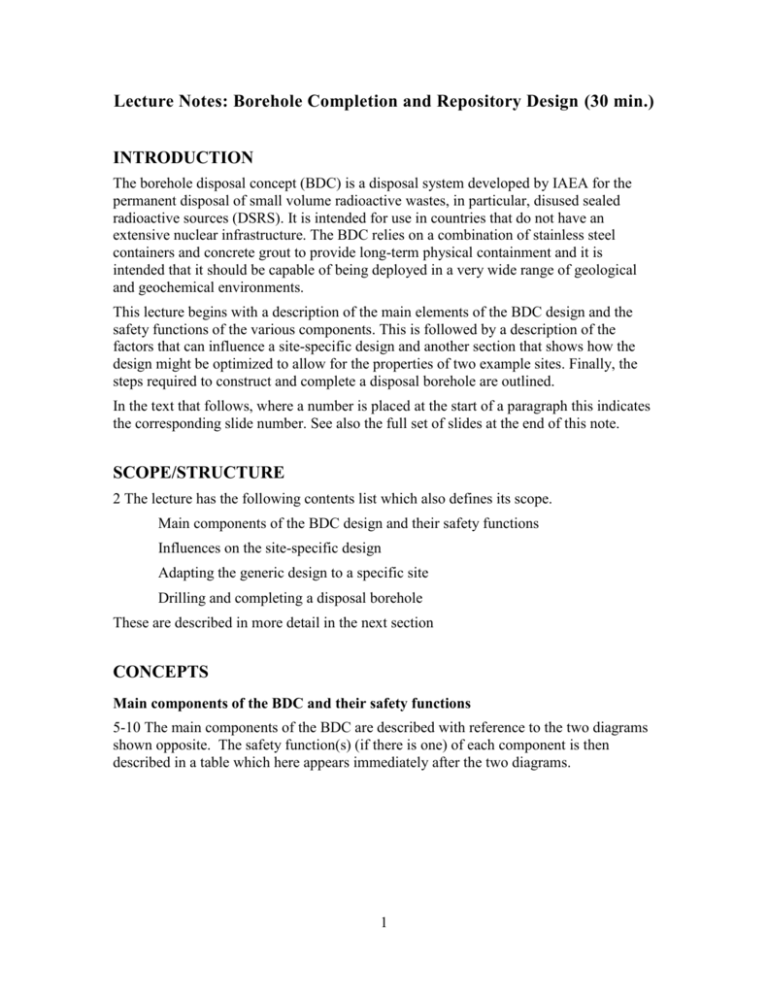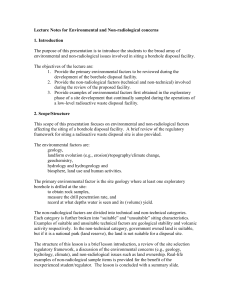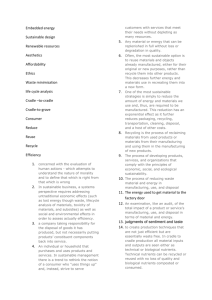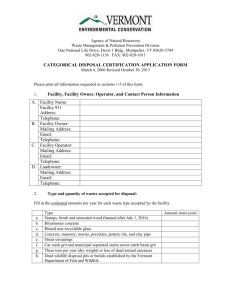18. Borehole Completion and Design
advertisement

Lecture Notes: Borehole Completion and Repository Design (30 min.) INTRODUCTION The borehole disposal concept (BDC) is a disposal system developed by IAEA for the permanent disposal of small volume radioactive wastes, in particular, disused sealed radioactive sources (DSRS). It is intended for use in countries that do not have an extensive nuclear infrastructure. The BDC relies on a combination of stainless steel containers and concrete grout to provide long-term physical containment and it is intended that it should be capable of being deployed in a very wide range of geological and geochemical environments. This lecture begins with a description of the main elements of the BDC design and the safety functions of the various components. This is followed by a description of the factors that can influence a site-specific design and another section that shows how the design might be optimized to allow for the properties of two example sites. Finally, the steps required to construct and complete a disposal borehole are outlined. In the text that follows, where a number is placed at the start of a paragraph this indicates the corresponding slide number. See also the full set of slides at the end of this note. SCOPE/STRUCTURE 2 The lecture has the following contents list which also defines its scope. Main components of the BDC design and their safety functions Influences on the site-specific design Adapting the generic design to a specific site Drilling and completing a disposal borehole These are described in more detail in the next section CONCEPTS Main components of the BDC and their safety functions 5-10 The main components of the BDC are described with reference to the two diagrams shown opposite. The safety function(s) (if there is one) of each component is then described in a table which here appears immediately after the two diagrams. 1 2 COMPONENT SAFETY FUNCTION/ DESIGN RATIONALE Disused sealed sources None – is assumed that the radionuclides in the sealed sources are free to migrate Capsule and container are made from corrosionresistant stainless steel which provide absolute physical containment for a time that is dependent on the rate of corrosion All these materials are cementitious. They produce high pH conditions that reduce the rate of container and capsule corrosion. The cement also provides surfaces on which radionuclides can sorb thereby retarding their migration Facilitates operation by supporting the borehole wall, excluding groundwater, providing a smooth surface to prevent snagging when emplacing waste packages It has no long-term safety function Facilitates operation by ensuring that the borehole is close to vertical Provides adequate concrete to provide pH buffering and dilution by spreading out any contaminant plume Prevents inadvertent drilling into the disposal zone Capsule Container Container backfill Repository backfill Borehole grout Casing Casing centraliser Container to container spacing Anti-intrusion plate Closure zone minimum 30m Concrete closure seal Casing removal (top 2m) Geosphere Provides isolation of the waste by placing it out of reach of normal deep excavation activities eg roads, foundations of buildings Seals the borehole and provides isolation of the wastes through its physical presence and containment of radionuclides by protecting the waste packages from damage and corrosion. Also retards migration of radionuclides through sorption A security measure that prevents unauthorized access to the waste by hiding the borehole location from sight. The precise location will be known to the authorities who, in any event, would have equipment that was capable of finding it Provides isolation of the wastes from the human environment and containment of radionuclides by protecting the waste packages from damage and corrosion. In the event of radionuclide migration from the facility, it will also provide retardation (through sorption) allowing more time for radionuclides to decay. The geosphere should have low resource potential to deter inadvertent human intrusion 3 Influences on the site-specific design 12 Many of the BDC design parameters are fixed (the waste package for instance) and, putting these aside, there are four general issues that have the capacity to influence the site-specific design. These may be divided into economic & practical matters, legislation & regulation, the waste inventory and the site properties. Safety assessment is used as a means of checking that the design is adequate. This is expressed in the diagram below. Economic and practical matters 13 A number of parameters will have an impact on the practicability and the cost of disposal and these could vary greatly between different countries. The most important of these is the choice of site, which may well be a governmental decision. Other examples are: Remoteness of the site and the ability to transport the sources there and the equipment needed to do the investigations and construct the borehole. Water will be needed to make the concrete and support human wellbeing and this may have to be transported to the site. Drilling contractors are widely available but not necessarily contractors who would be qualified to perform the required site investigations. The disposal borehole has a diameter of at least 0.26m and this size is widely used for water extraction equipment so the equipment will often be available locally Availability of construction and emplacement materials eg casing, cement, sand, water 4 The site properties (groundwater, weathered zone, geological complexity, topography…) will have an impact on the difficulty (hence cost) of the site investigations, Geological complexity could make it difficult to make an acceptable safety case Finally potential licensees should not underestimate the effort required to have useful Stakeholder and Regulatory interactions. These activities can be very time consuming Legislation & regulation 14 Potential licensees need need to have a very good understanding of how the law and regulations will impact on what is planned. In brief the regulations will determine the safety standards to be met. In general we would expect these to be similar to IAEA standards – especially if the Model Regulations are used as a basis. That said, some countries may impose other restrictions e.g. the format of the safety case or safety assessment, who is permitted to design the facility, the need (or not) for retrievability If the Model Regulations are used, almost all of these issues will have been answered by the design Waste inventory 15 Compared to the disposal of nuclear power plant wastes, characterization of an inventory of disused sealed sources is straightforward because the wastes (the disused sealed sources) generally contain only one radionuclide. The key parameters to be determined for each source are: Identification of radionuclide/ nuclear reaction/ emissions (hence half-life) Activity at a specified date Physical size of sources to be placed into each capsule (after removal of the source from the associated equipment and shielding) Current storage and handling arrangements / means of retrieval from store / weight to be lifted Means of removal of bare source from operating shield Need for shielding during conditioning/ containerization Of these, the parameters that are most relevant to the design are the physical size of the sources and their activity because (assuming that different radionuclides can be mixed in one package) these will largely determine the number of waste packages and, hence, the required overall length of the disposal zone. 16 The inventory will also influence the extent to which long-term physical containment will need to be relied upon in the safety case. The figure that follows indicates this. The left hand side of the figure shows radionuclides that are commonly used for sealed sources. The axis at the bottom shows years. The individual bars indicate the number of years needed for a source to decay to exemption levels; the width of the bars represents the range of radioactivity typically found in the various types of source that use this radionuclide. Hence the figure provides an indication of the length of time that a radioactive source would need to be contained in order for the radionuclide inside it to decay in situ to its exemption level. In the case of Pu-239 (half life 24,000 years) the time 5 can be in excess of 1 million years but, that said, Pu-239 is an unusual radionuclide to find in a disused sealed source. More commonly encountered is Ra-226 (half life 1600 years) which, even for the largest sources would require less than 20,000 years to reach exemption levels. Such considerations will not affect the site-specific design but they will affect the focus of the safety case. Site properties 17 Site properties are dealt with elsewhere (under site characterization) but, in summary, the most important ones for the BDC are (in no particular order) Depth to water table Existence of near-surface weathered rocks Separation of near-surface and deep water bodies Rate of surface erosion/ geomorphology Properties of potential host geology o Structural o Geomechanical o Geochemical o Etc Adapting the generic design to a specific site The most important design issues needing to be decided - and their most likely method of resolution - are listed in the following table 6 ISSUE HOW DECIDED Which site? Governmental or community decision Where on the site? Avoid large faults, nearby surface facilities How many boreholes, what depth? Design optimization based on the inventory and the site properties – see below New borehole or modify existing characterization borehole? Largely an economic and practical issue 20 The issue of design optimization is first addressed by determination of the required total length of the disposal zone. This is equal to the number of packages multiplied by the package to package spacing. The number of packages is dependent on the number, geometry and type of disused sealed sources. The number of sources that can be placed inside a capsule depends upon the size of the sources and the size of the capsule (two are currently available: small and large). All conditioning to date has ensured that radionuclides are not mixed within a capsule but, provided that is chemical compatibility, this need not be the case. Mixing of sources and use of the larger capsule could greatly reduce the number of waste packages and, thus the length of the disposal zone. Of course, the larger packages would have to be consistent with handling requirements – less than 1 Ci of Co-60 in the lightly shielded conditioning facility. The BDC reference design has a package to package spacing of 1m but, if this could be reduced to, say, 0.5m, it would half the length of the disposal zone and have knock-on benefits in terms of cost. The reduction in spacing could have an effect on safety in the long term (after the packages have degraded) but this effect is probably extremely small, Calculations would be needed to confirm this. Having established the overall length of the disposal zone we then look to optimize the design to make best use of the site. We do this by reference to two examples. 7 21 The minimum depth of disposal is 30m but in the case shown above the water table depth varies between (say) 25m depth in the rainy season and 32m depth in the dry season. To avoid the fluctuating phreatic surface the disposal should be placed below the minimum groundwater depth. In this case a decision over whether there should be one or two boreholes may be largely an economic matter. The cost per metre of a borehole increases with depth; on the other hand two boreholes will require two closure zone ie much more concrete. 8 22 A second hypothetical example is shown in the first of the two figures above. A suitable host rock exists from 20 to 70m depth. Below this is an aquifer that may not always be fully saturated ie the water does not extend to the top of the aquifer. This is a feature to be avoided because, while the BDC can tolerate fully saturated or fully unsaturated conditions, cycling between the two is undesirable. The disposal zone must also be deeper than 30m. This means that the available suitable host rock has a thickness of 40 metres. If the required disposal zone length were 70m, a single borehole would extend to 100m (30m minimum depth plus 70m) which would intrude into the aquifer. An acceptable way of avoiding this would be to drill two disposal boreholes (lower of the two figures above). 9 Drilling and completing a disposal borehole 24 The BDC is designed to use techniques that are widely available. The borehole minimum diameter of 0.26m minimum is typical of boreholes used for groundwater abstraction. A rotary air percussion drill would normally be used. This does not allow coring but for the disposal borehole this is not strictly necessary. Samples of chippings should be retained for every metre of borehole however. The figure above illustrates rotary air percussion drilling 25-30 The sequence of activities for borehole construction is as follows: Borehole drilling to full depth Insertion of mild steel or high density polyethylene (HDPE). The diameter of the casing should be such that, with a 260mm borehole, the annular gap between the casing and the borehole wall is more than 50mm. Centralisers are used to make sure that the casing sits centrally in the borehole. The 50mm gap should provide sufficient space to allow a tremmie pipe to be inserted for grouting. Formation of a bottom plug by inserting a tremmie pipe into the annulus and running it to the bottom of the borehole. Grout is then pumped through the tremmie pipe to form a concrete plug that holds the bottom of the casing in place. Once the plug has hardened (overnight) the annulus itself is grouted, again using the tremmie pipe (see photograph below). After checking its as-built status, the borehole is then ready for waste emplacement. 10 DEFINITIONS AND ABBREVIATIONS Most of the words and expression used in these notes can be found in the IAEA Safety Glossary or an ordinary English dictionary. Those that are specific to the BDC may be found below BDC Borehole disposal concept Capsule A small, 3mm thick stainless steel container into which disused sealed sources are placed prior to storage. Conditioning The placing of a disused sealed source into a capsule followed by seal welding and leak testing. Container A 6mm thick stainless steel vessel into which filled capsules are placed prior to disposal. Containerization The act of placing a capsule into a BDC container followed by seal welding and leak testing. DSRS Disused sealed radioactive source(s). SOURCES OF INFORMATION/REFERENCES INTERNATIONAL ATOMIC ENERGY AGENCY, Disposal of Radioactive Waste, IAEA Safety Standards Series No. SSR-5, IAEA, Vienna (2011). INTERNATIONAL ATOMIC ENERGY AGENCY, Borehole Disposal Facilities for Radioactive Waste, IAEA Safety Standards Series No. SSG-1, IAEA, Vienna (2009). INTERNATIONAL ATOMIC ENERGY AGENCY, BOSS: Borehole Disposal of Disused Sealed Sources. A Technical Manual, IAEA-TECDOC-1644 Vienna (2011) INTERNATIONAL ATOMIC ENERGY AGENCY, DRAFT SAFETY REPORT, GENERIC POST-CLOSURE RADIOLOGICAL SAFETY ASSESSMENT (GSA), BOREHOLE DISPOSAL OF DISUSED SEALED SOURCES INTERNATIONAL ATOMIC ENERGY AGENCY, IAEA Safety Glossary: Terminology Used in Nuclear Safety and Radiation Protection, Vienna (2007). SUMMARY OF THE LESSON The lesson has covered Main components of the BDC design and their safety functions o Containers and capsule, backfill, casing etc Influences on the site-specific design o Practical/ regulatory/ inventory/ site properties Adapting (optimizing) the generic design for a specific site o Two examples given – one leads to one borehole, the other, two Steps in the construction of a disposal borehole 11 QUESTIONS 1. What are the safety functions of the borehole casing? (a) to aid emplacement of waste packages (b) to exclude groundwater during operations (c) to prevent long-term radionuclide migration by excluding groundwater (d) to produce a localised geochemical regime that is favourable for radionuclide retention Answer (a) and (b) are correct. (c) and (d) refer to long term safety but the casing has no long-term safety function 2. What are the safety functions of disused sealed sources in the BDC? (a) Physical containment provided by the seal (b) Low mobility because of the chemical compounds used (c) None Answer: only (c) is correct. 3. What are the safety functions of the repository backfill? (a) Produces high pH conditions which reduces the corrosion rate of the stainless steel (b) Provides physical containment (c) Provides surfaces on which radionuclides can sorb, thus retarding their migration Answer (a) and (c) are correct. (b) is incorrect because the concrete could crack 4. The safety of the BDC rests partly on long-term physical retention of radionuclides. What aspects of the design contribute to this? (a) the combination of concrete and stainless steel (b) choice of site (c) choice of depth of disposal (d) regulatory requirements Answer (a) to (c) are correct. Regulatory requirements (d) are not part of the design 5. 30 metres is the minimum depth of disposal for the BDC. Why? 12 (a) It is a depth at which inadvertent human intrusion is thought to be very unlikely (b) It is below the weathered zone (c) It is above the saturated zone (d) It is below the saturated zone (e) Less than 30m is defined as near-surface disposal Answer only (a) is correct. 6. 30 metres is the minimum depth of disposal for the BDC. Why? (a) It is a depth at which inadvertent human intrusion is thought to be very unlikely (b) It is below the weathered zone (c) It is above the saturated zone (d) It is below the saturated zone (e) Less than 30m is defined as near-surface disposal Answer: only (a) is correct. 7. In what way will the inventory for disposal affect the site-specific design? (a) Need for long-term containment (b) Host geology (c) Length of the disposal zone (d) Minimum depth of disposal Answer: only (c) is correct. 8. Why will a Ra-226 sealed source require more extended physical containment than a Cs-137 sealed source? (d) Caesium reacts with the stainless steel (e) Ra-226 has a much longer half-life than Cs-137 (f) Radium is more mobile than caesium (g) Minimum depth of disposal Answer: only (b) is correct. 13 14 15 16 17 18 19 20 21








